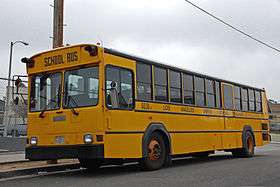Gillig Phantom (school bus)
| Gillig Phantom School Bus | |
|---|---|
 1986 Gillig Phantom School Bus operated by Los Angeles Unified School District | |
| Overview | |
| Manufacturer | Gillig Corporation |
| Production | 1986–1990, 1993 |
| Model years | 1986-1993 |
| Assembly | United States: Hayward, California |
| Body and chassis | |
| Class | School bus |
| Body style | Transit-style school bus (Type D) |
| Layout | RR layout (4x2) |
| Platform | Gillig |
| Related | Gillig Phantom |
| Powertrain | |
| Engine |
Caterpillar 10.4L 3208 V8 Caterpillar 6.6L 3116 I6 Detroit Diesel 9.0L 6V92TA V6 |
| Transmission |
Allison HT-740, Allison MT-643 4-speed automatic Spicer CM5252A, 6252B, Fuller T11605M 5-speed manual Fuller Roadranger RT6610, Roadranger RT11610 10-speed manual |
| Dimensions | |
| Length | 37 ft (11.3 m), 40 ft (12.2 m) |
| Width | 96 in (2,438 mm) |
| Chronology | |
| Predecessor | Gillig Transit Coach school bus |
The Gillig Phantom School Bus is the school bus variant of the Gillig Phantom mass-transit bus that was produced by Gillig Corporation in Hayward, California. Introduced in 1986, production of the Phantom school bus ended after 1993.
In a fashion similar to its long-running predecessor, the Gillig Transit Coach School Bus, the Phantom School Bus was available on a national basis, though marketed primarily for West Coast operators. Although initially well-received, sales of the vehicle dropped off at the end of the 1980s. After no school buses were sold in either 1991 or 1992, a short run of 1993 models marked the end of 71 years of Gillig as a school bus manufacturer.
Design overview
Using much of the mass-transit Gillig Phantom as a donor platform, Gillig produced the Phantom School Bus in a rear-engine configuration. While a rear-engine configuration had been used in its Transit Coach predecessor, the Phantom chassis was completely new from the ground up. As a consequence of the Phantom chassis design, Gillig was forced to abandon the mid-engine chassis configuration used by the Transit Coach. While becoming common in motorcoach and mass-transit buses, the monocque (unibody) chassis of the Phantom was largely untried in school bus manufacturing (with the notable exception of the Crown Supercoach).
Gillig offered the Phantom School Bus in two body lengths during its production: 37 feet (78 passenger capacity) and 40 feet (84 passenger capacity). As federal regulations of the time did not permit the use of a 102" width body for a school bus, the Phantom School Bus used the narrower 96" body width of the Phantom (discontinued in 2004).
For its 1986 introduction, Gillig offered the Phantom School Bus a range of diesel engines, including the Caterpiller 3208 V8 (school buses were largely the only Phantoms with this engine) and the Detroit Diesel 6V92TA (replacing the 6V71 from the Transit Coach). With the withdrawal of the Caterpillar 3208 after 1990, it was replaced by the 3116 inline-6; it is unknown how many Phantoms were fitted with this engine.
The Phantom school bus was available with several transmission choices; all of which were carried over from the Transit Coach. The Allison MT643 and Allison HT740 4-speed automatics were paired with both engines. For school districts with mountainous terrain, the Phantom offered five manual transmission options: three 5-speed versions (Spicer CM5252A, 6252B, and Fuller T11605M) and two 10-speed versions (Fuller Roadranger RT6610 and RT11610).
Design modifications
To convert the Phantom to the Phantom School Bus, Gillig made a number of changes to the exterior and interior for the Gillig Phantom to comply with school bus design standards at both state and federal levels. While the most distinctive changes were the addition of school bus yellow exterior paint and the fitment of high-back forward-facing padded seats of school buses, a number of other design changes were phased in as well.
On the forward section of the body, the sloping driver windshield was replaced by vertically-mounted glass (matching the other half). In a change from its mass-transit counterpart, the quad headlights were deleted in favor of dual headlights (though quad headlights later became an option ordered by some operators). To properly meet design regulations, the Phantom School Bus adopted larger sideview mirrors, convex mirrors, and front cross-view mirrors. To give the vehicle traffic priority, red warning lights (with amber lights, for Phantom school buses sold outside of California) were fitted in the front and rear roof caps (a side stop arm was fitted).
On the rear section of the body, an emergency exit window was added, as it was required under design standards.
A number of changes were focused on the sides of the body. As the vehicle was to be used for school routes and not for transit use, the rear curbside exit was deleted (a design change also forced by regulations). On the drivers' side of the bus, an emergency exit door was added to the left side of the bus (a requirement for rear-engine school buses). In place of transit-style windows, narrower split-sash windows (required for school buses) were fitted to the body. To reinforce the body structure, Gillig added two full-length steel rails below the window line; unlike most school buses, the structure of the Phantom was additionally reinforced above the window line as well.
The Phantom School Bus was not factory-produced with a wheelchair lift, with the transit-style wheelchair lift deleted from stepwell. As a result, the entry door on the Phantom School Bus was several inches narrower than its mass-transit counterpart. However, Gillig continued to offer a kneeling feature from the mass-transit Phantom as an option, allowing the driver to lower the front of the bus to curb level when loading/unloading passengers.
Further reading
- Gillig Transit Coach / Pacific SchoolCoach Online Museum, gilligcoaches.net, Retrieved on 2006-12-25
- Gillig History, gillig.com, Retrieved on 2015-6-10